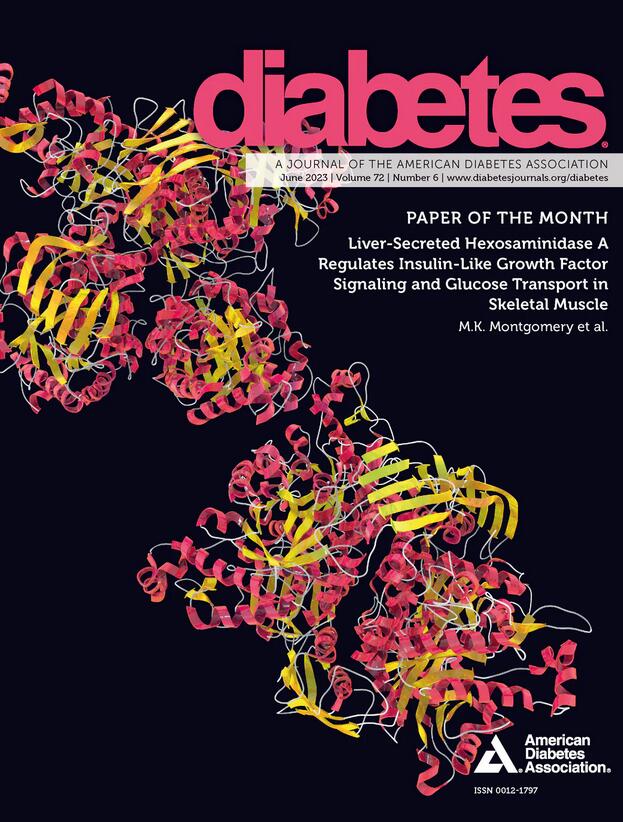新发 1 型糖尿病和自身抗体阳性兄弟姐妹中升高的 cathepsin S 血清水平
IF 6.2
1区 医学
Q1 ENDOCRINOLOGY & METABOLISM
引用次数: 0
摘要
越来越多的数据表明,溶酶体蛋白酶 cathepsin S(CTSS)在 1 型糖尿病中发挥作用。循环中的 CTSS 在 1 型糖尿病患者中有所增加,但 CTSS 是具有保护作用还是有害作用尚不清楚。本研究的目的是检测 CTSS 在新发 1 型糖尿病中的生物标记潜力,并研究 CTSS 在人类胰岛和 β 细胞中的表达和分泌情况。通过酶联免疫吸附法分析了新发1型糖尿病患儿及自身抗体阳性和阴性兄弟姐妹血清中的CTSS水平。通过实时 qPCR、免疫印迹和 ELISA 评估了 CTSS 在分离的人胰岛和 EndoC-βH5 细胞中的表达和分泌情况。新发 1 型糖尿病患儿的 CTSS 血清水平升高,而健康兄弟姐妹的 CTSS 水平与自身抗体状态呈正相关。人胰岛和EndoC-βH5细胞在暴露于促炎细胞因子(一种胰岛炎症模型系统)后显示出CTSS的诱导和分泌。对公开的人类胰岛单细胞 RNA 测序数据的分析表明,与非糖尿病供体相比,1 型糖尿病供体的 β 细胞独有 CTSS 表达的升高。这些发现表明 CTSS 有可能成为 1 型糖尿病的诊断生物标志物。本文章由计算机程序翻译,如有差异,请以英文原文为准。
Elevated cathepsin S serum levels in new-onset type 1 diabetes and autoantibody-positive siblings
Accumulating data suggest a role for the lysosomal protease cathepsin S (CTSS) in type 1 diabetes. Circulating CTSS is increased in type 1 diabetes; however, whether CTSS has protective or deleterious effects is unclear. The study’s objectives were to examine the biomarker potential of CTSS in new-onset type 1 diabetes, and to investigate the expression and secretion of CTSS in human islets and β cells. The CTSS level was analyzed in serum from children with new-onset type 1 diabetes and autoantibody-positive and -negative siblings by ELISA. The expression and secretion of CTSS were evaluated in isolated human islets and EndoC-βH5 cells by real-time qPCR, immunoblotting, and ELISA. The CTSS serum level was elevated in children with new-onset type 1 diabetes and positively associated with autoantibody status in healthy siblings. Human islets and EndoC-βH5 cells demonstrated induction and secretion of CTSS after exposure to pro-inflammatory cytokines, a model system of islet inflammation. Analysis of publicly available single-cell RNA sequencing data on human islets showed that elevated CTSS expression was exclusive for the β cells in donors with type 1 diabetes as compared to non-diabetic donors. These findings suggest a potential of CTSS as a diagnostic biomarker in type 1 diabetes.
求助全文
通过发布文献求助,成功后即可免费获取论文全文。
去求助
来源期刊

Diabetes
医学-内分泌学与代谢
CiteScore
12.50
自引率
2.60%
发文量
1968
审稿时长
1 months
期刊介绍:
Diabetes is a scientific journal that publishes original research exploring the physiological and pathophysiological aspects of diabetes mellitus. We encourage submissions of manuscripts pertaining to laboratory, animal, or human research, covering a wide range of topics. Our primary focus is on investigative reports investigating various aspects such as the development and progression of diabetes, along with its associated complications. We also welcome studies delving into normal and pathological pancreatic islet function and intermediary metabolism, as well as exploring the mechanisms of drug and hormone action from a pharmacological perspective. Additionally, we encourage submissions that delve into the biochemical and molecular aspects of both normal and abnormal biological processes.
However, it is important to note that we do not publish studies relating to diabetes education or the application of accepted therapeutic and diagnostic approaches to patients with diabetes mellitus. Our aim is to provide a platform for research that contributes to advancing our understanding of the underlying mechanisms and processes of diabetes.
 求助内容:
求助内容: 应助结果提醒方式:
应助结果提醒方式:


